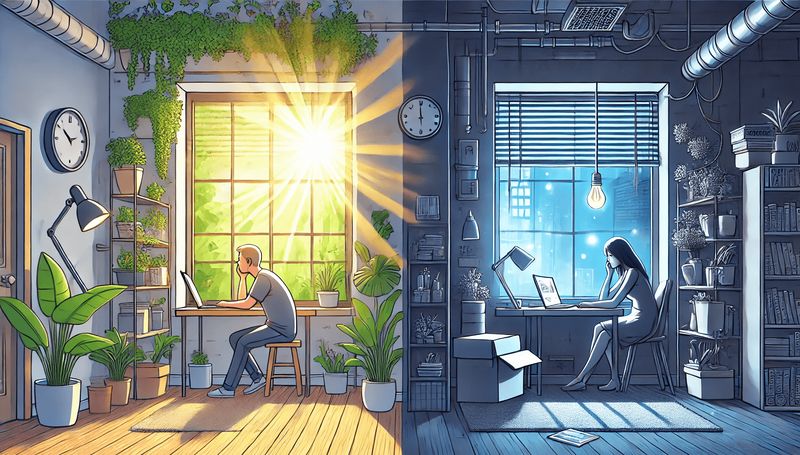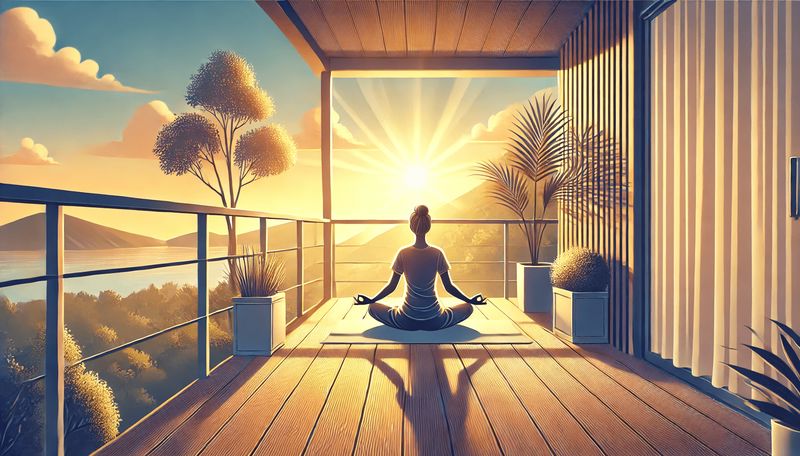The connection between light and mental health is more profound than most people realize. Its’ influences our feelings, sleep patterns, and overall mental well-being. Whether it’s the sunlight that brightens our days or artificial lighting that illuminates our evenings, the type and quality we are exposed to can significantly impact our emotional state.
Research shows that exposure to natural illumination can improve your mood and reducing anxiety. Conversely, insufficient or poor-quality lighting, especially during winter months, can lead to seasonal affective disorder (SAD) and other emotional state disturbances.

Light Therapy for Mood
Light therapy has emerged as a powerful tool in the battle against mood disorders, especially during the darker months when exposure to natural sunlight is limited. The premise is simple yet effective: using artificial beams to simulate natural sunlight, such therapy aims to restore the body’s internal clock and elevate emotional state.
This form of therapy is particularly beneficial for individuals suffering from ‘SAD’, a type of depression that occurs during the fall and winter months. The bright artificial illumination used in therapy mimics sunlight, helping to trigger the release of serotonin, a hormone closely associated with feelings of happiness and well-being.
The quality and intensity of illumination are crucial. Lightboxes used in therapy are designed to emit bright, full-spectrum light without UV rays, making them safe and effective for daily use.
Research suggests that exposure to this type of shine for just 20 to 30 minutes each morning can significantly improve mood, increase energy levels, and regulate sleep patterns. For those who find themselves feeling sluggish, irritable, or down during the winter months, this therapy could be a game changer, offering a simple yet impactful solution for feelings enhancement.
How Different Types of Light Affect Your Health
The type of light we are exposed to can have a profound impact on our health. From natural sunlight to various forms of artificial illumination, each type influences our mood, energy levels, and overall well-being in unique ways. Understanding these differences is essential for optimizing mental health and well-being.
- Natural Sunlight is perhaps the most significant source of light for health. Sunlight boosts the production of serotonin, a hormone that stabilizes emotional state and promotes feelings of happiness. Influence of natural beams, especially in the morning, helps regulate our circadian rhythms, leading to better overall mental clarity. However, for many people, getting enough sunlight is challenging, particularly in winter months or for those living in northern latitudes.
- Artificial Light comes in many forms, and its impact on mental health can vary widely. Full-spectrum bulbs, designed to mimic daylight, are often used in the therapy to treat SAD and other mood disorders. On the other hand, fluorescent lighting, commonly found in office environments, can have a negative impact, causing headaches, eye strain, and increased stress levels. The quality and type of artificial illumination are crucial in determining its effect on mood. LED lighting, which can be adjusted in brightness and color temperature, is considered a better option for mental well-being, especially in work environments.
- Blue Light is a high-energy visible ray emitted by screens on smartphones, computers, and other digital devices. While blue light affects during the day can boost alertness and cognitive function, excessive influence at night can disrupt sleep by inhibiting the production of melatonin (the sleep hormone). This disruption can lead to poor sleep quality, heightened stress levels, and a negative impact on mental health over time.
To promote better mental health, it is important to consider both the type and timing of this effect. Utilizing natural shine during the day, reducing this effect in the evening, and choosing appropriate artificial lighting can all contribute to a healthier, more balanced state of mind.

The Surprising Psychological Effects of Light Exposure
It significantly influences our psychological state, impacting everything from mood to cognitive function. Natural one, for instance, Serves as a linchpin in regulating our circadian rhythms, which govern our sleep-wake cycles. This synchronization is essential for mental health, as disrupted rhythms can lead to insomnia, anxiety and depression. In contrast, prolonged influence of artificial illumination, especially blue glow from screens, can suppress melatonin production, making it harder to fall asleep and negatively affecting feelings and cognitive performance.
On a more immediate level, bright, natural beams has been shown to boost serotonin and energy levels almost instantly. Conversely, dim or poor-quality lighting environments can lead to increased feelings of sadness or lethargy.
Can Light Therapy Help with Mood Disorders?
Light exposure plays a pivotal role in regulating our mental health, significantly impacting mood disorders such as anxiety disorder, bipolar disorder, and depressive disorder. The relationship between light and mood is intricately linked to our circadian rhythm, the natural internal clock that guides sleep-wake cycles, hormonal release, and other essential bodily functions.
For individuals with depressive disorders, especially SAD, lack of natural rays during the winter months can trigger or worsen symptoms. The therapy, which involves exposure to artificial illumination that mimics natural sunlight, has been shown to improve emotional state and alleviate depression by regulating serotonin and melatonin levels, thereby resetting the circadian rhythm.
Anxiety disorders are also influenced by sunshine. Insufficient sun or excessive blue glow from screens can disrupt sleep patterns, which are closely linked to anxiety levels. Proper illumination exposure, particularly in the morning, helps stabilize the circadian rhythm, reducing anxiety symptoms.
For those with bipolar disorder, managing such influence is crucial. Bright Therapy can be effective for depressive episodes; however, too much light or irregular exposure can trigger manic episodes. This delicate balance underscores the importance of tailored influence to manage mood disorders effectively.
Additionally, irregular illumination can have cardiometabolic effects by disrupting sleep and eating patterns, leading to increased risks of cardiovascular diseases and metabolic disorders such as diabetes. Proper light effect helps maintain a regular circadian rhythm, promoting not just mental health but also physical well-being.
Key Takeaways:
- Depressive Disorders: The therapy can help alleviate symptoms by regulating serotonin and melatonin.
- Anxiety Disorders: Adequate morning beams exposure help reduce anxiety by stabilizing the circadian rhythm.
- Bipolar Disorder: Shining needs careful management to avoid triggering manic episodes.
- Cardiometabolic Health: Consistent influence supports a stable circadian rhythm, reducing the risk of metabolic and cardiovascular disorders.
Medical Benefits of Light Exposure for Mood Regulation
Daylight has a profound medical impact on mood, influencing various psychological and physiological processes. Exposure to natural beams, particularly in the morning, plays a crucial role in regulating the body’s circadian rhythm—a key factor in maintaining health.
The circadian rhythm – our internal biological clock, governs sleep-wake cycles and hormone release, including serotonin and melatonin, which are vital for mood regulation.
However, it is not just the presence of illumination but its quality and timing that matter. Too much artificial rays, especially from screens in the evening can have the opposite effect. Understanding these dynamics is essential for leveraging light’s medical benefits for mood regulation.

The Role of Light in Regulating Your Sleep Cycle
The quality of your sleep is closely tied to the type and timing of illumination you receive throughout the day.
Especially natural sunlight, this is a primary regulator of the circadian rhythm—our body’s internal clock that dictates sleep-wake cycles. Morning exposure to bright, natural illumination helps synchronize this rhythm, promoting alertness during the day and restful sleep at night.
Artificial illumination (particularly blue ones) poses a significant challenge to sleep quality. Exposure to blue illumination in the evening can interfere with melatonin production, the hormone responsible for inducing sleep. This disruption can make it harder to fall asleep and reduce sleep depth, leading to restless nights and groggy mornings.
For optimal sleep, it’s crucial to minimize such influence at least an hour before bedtime.
Interestingly, the color and intensity of luminescence also play a role. Warm, dim lights in the evening help signal to the body that it’s time to wind down, preparing the mind for sleep.
How Natural Light Boosts Mood, Sleep, and Productivity?
It is more than just a source of illumination; it is a powerful contributor to our overall well-being. Exposure to natural sunlight boosts the production of vitamin D, a vital nutrient that supports bone health, immune function, and mood regulation.
Spending time in natural beams can significantly enhance mood and reduce symptoms of depression and anxiety. Sunlight triggers the release of serotonin, a hormone associated with feelings of happiness and calm. This makes such exposure especially crucial during the shorter days of winter when sunlight is scarce. In workplaces and schools, access to natural illumination has been linked to increased productivity and improved concentration.
Moreover, it can improve sleep quality by helping to regulate the body’s production of the hormone responsible for sleep. By aligning our daily activities with natural sunlight cycles, we can achieve deeper, more restful sleep. Embracing natural illumination in our environments not only enhances our physical health but also nurtures our emotional and mental well-being.

The Dark Side of Artificial Light
Artificial light, while a convenient solution for illuminating our homes and workplaces, can have a significant impact on mental health, particularly when it comes to depression. Prolonged exposure (especially at night) disrupts the body’s natural circadian rhythm, which is critical for regulating sleep patterns and mood. This disruption can lead to a decrease in the production of melatonin and can elevate stress levels, contributing to the onset or worsening of depressive symptoms.
Moreover, the quality of artificial illumination matters. Fluorescent and LED lights, commonly used in indoor settings, emit blue glow, which is known to suppress melatonin production more than other types of illumination. For individuals already prone to mood disorders, such as SAD or chronic depression, influence of blue screen in the evening can exacerbate feelings of sadness, anxiety, and fatigue.
However, not all artificial glow is harmful!
Properly timed exposure to bright, full-spectrum illumination in the morning can mimic the effects of natural sunlight, boosting serotonin levels and alleviating symptoms of depression. Understanding the nuances of it and making conscious choices about lighting can play a crucial role in managing depression and enhancing mental well-being.
Embracing the right balance of light exposure is not just about illuminating our spaces—it’s about illuminating our lives with better health and a brighter outlook.
